中国文化导读课件10
- 格式:pps
- 大小:1.30 MB
- 文档页数:53
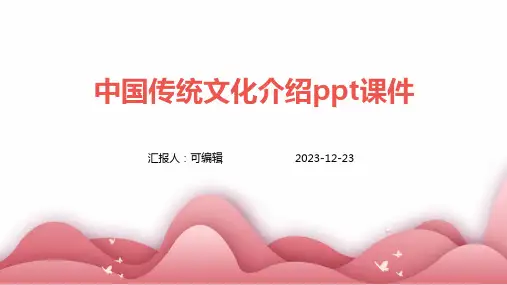
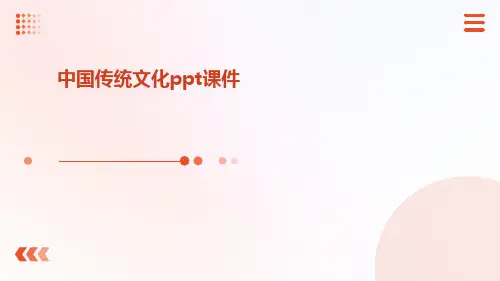
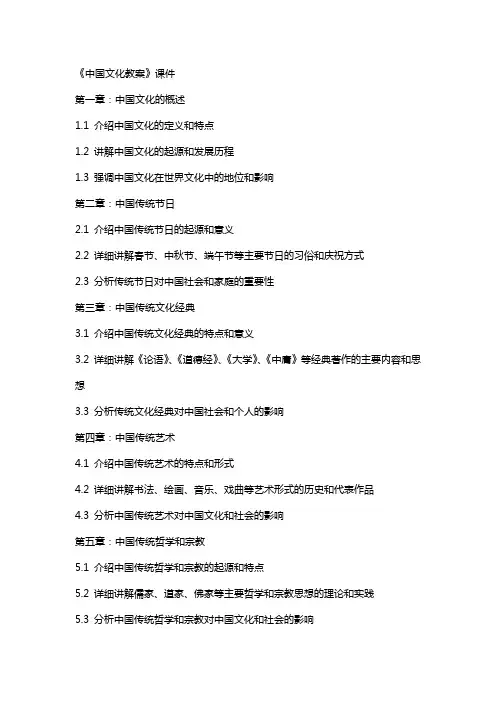
《中国文化教案》课件第一章:中国文化的概述1.1 介绍中国文化的定义和特点1.2 讲解中国文化的起源和发展历程1.3 强调中国文化在世界文化中的地位和影响第二章:中国传统节日2.1 介绍中国传统节日的起源和意义2.2 详细讲解春节、中秋节、端午节等主要节日的习俗和庆祝方式2.3 分析传统节日对中国社会和家庭的重要性第三章:中国传统文化经典3.1 介绍中国传统文化经典的特点和意义3.2 详细讲解《论语》、《道德经》、《大学》、《中庸》等经典著作的主要内容和思想3.3 分析传统文化经典对中国社会和个人的影响第四章:中国传统艺术4.1 介绍中国传统艺术的特点和形式4.2 详细讲解书法、绘画、音乐、戏曲等艺术形式的历史和代表作品4.3 分析中国传统艺术对中国文化和社会的影响第五章:中国传统哲学和宗教5.1 介绍中国传统哲学和宗教的起源和特点5.2 详细讲解儒家、道家、佛家等主要哲学和宗教思想的理论和实践5.3 分析中国传统哲学和宗教对中国文化和社会的影响第六章:中国饮食文化6.1 介绍中国饮食文化的特点和影响6.2 详细讲解中国传统食材、烹饪技巧和餐具使用6.3 分析中国饮食文化在中国文化中的地位和作用第七章:中国传统建筑7.1 介绍中国传统建筑的风格和特点7.2 详细讲解宫殿、庙宇、园林等不同类型的建筑特点和代表实例7.3 分析中国传统建筑对中国文化和社会的影响第八章:中国历史与文化名城8.1 介绍中国历史文化名城的背景和特点8.2 详细讲解北京、西安、洛阳、南京等历史文化名城的历史和文化价值8.3 分析历史文化名城对中国文化保护和发展的重要性第九章:中国传统民俗与民间信仰9.1 介绍中国传统民俗和民间信仰的起源和特点9.2 详细讲解婚礼、丧葬、生育等民俗习惯以及妈祖、城隍等民间信仰9.3 分析民俗和民间信仰对中国社会和个人的影响第十章:中国现代文化的发展与挑战10.1 介绍中国现代文化的发展趋势和特点10.2 分析中国现代文化面临的挑战和变革,如互联网、全球化等影响10.3 探讨中国现代文化的发展方向和对策重点和难点解析一、中国文化的概述难点解析:如何准确阐述中国文化的起源,以及其发展过程中的关键节点。
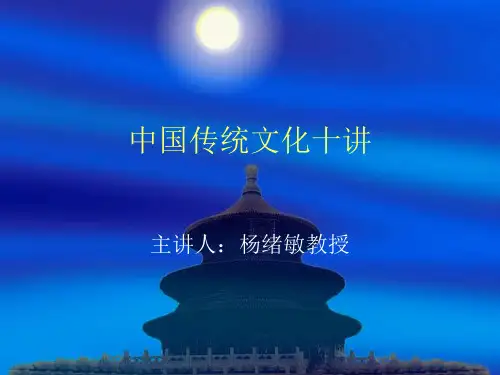
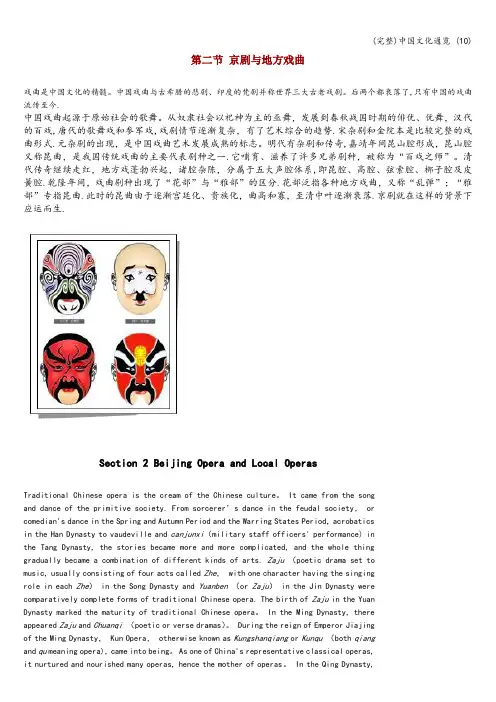
第二节京剧与地方戏曲戏曲是中国文化的精髓。
中国戏曲与古希腊的悲剧、印度的梵剧并称世界三大古老戏剧。
后两个都衰落了,只有中国的戏曲流传至今.中国戏曲起源于原始社会的歌舞。
从奴隶社会以祀神为主的巫舞,发展到春秋战国时期的俳优、优舞,汉代的百戏,唐代的歌舞戏和参军戏,戏剧情节逐渐复杂,有了艺术综合的趋势.宋杂剧和金院本是比较完整的戏曲形式.元杂剧的出现,是中国戏曲艺术发展成熟的标志。
明代有杂剧和传奇,嘉靖年间昆山腔形成,昆山腔又称昆曲,是我国传统戏曲的主要代表剧种之一.它哺育、滋养了许多兄弟剧种,被称为“百戏之师”。
清代传奇继续走红,地方戏蓬勃兴起,诸腔杂陈,分属于五大声腔体系,即昆腔、高腔、弦索腔、梆子腔及皮簧腔.乾隆年间,戏曲剧种出现了“花部”与“雅部”的区分.花部泛指各种地方戏曲,又称“乱弹”;“雅部”专指昆曲.此时的昆曲由于逐渐宫廷化、贵族化,曲高和寡,至清中叶逐渐衰落.京剧就在这样的背景下应运而生.Section 2 Beijing Opera and Local OperasTraditional Chinese opera is the cream of the Chinese culture。
It came from the songand dance of the primitive society. From sorcerer’s dance in the feudal society, orcomedian's dance in the Spring and Autumn Period and the Warring States Period, acrobaticsin the Han Dynasty to vaudeville and canjunxi(military staff officers' performance) inthe Tang Dynasty, the stories became more and more complicated, and the whole thinggradually became a combination of different kinds of arts. Zaju(poetic drama set tomusic, usually consisting of four acts called Zhe, with one character having the singingrole in each Zhe) in the Song Dynasty and Yuanben(or Zaju) in the Jin Dynasty werecomparatively complete forms of traditional Chinese opera. The birth of Zaju in the YuanDynasty marked the maturity of traditional Chinese opera。
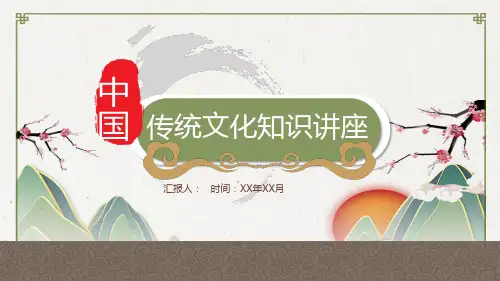
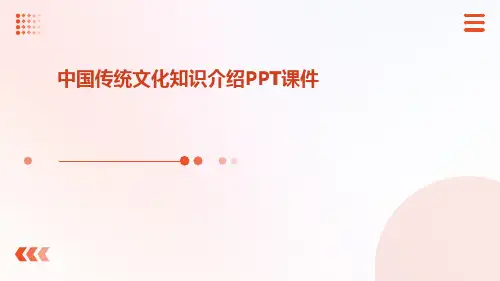
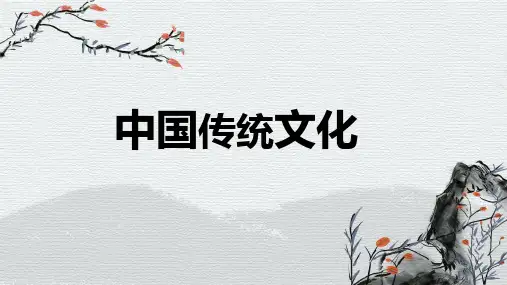
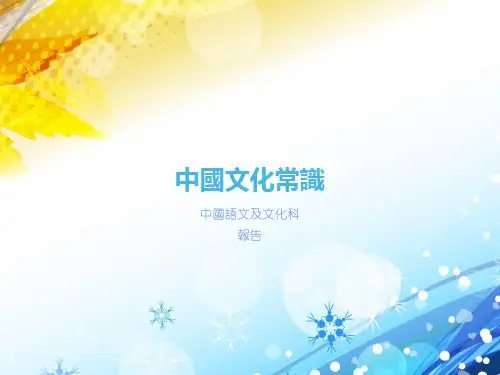
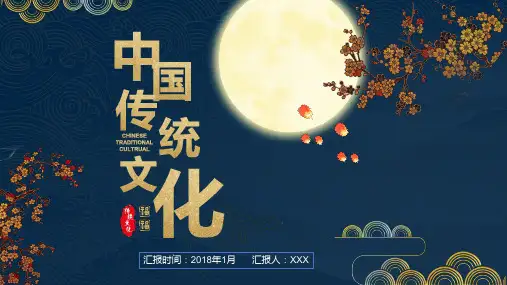
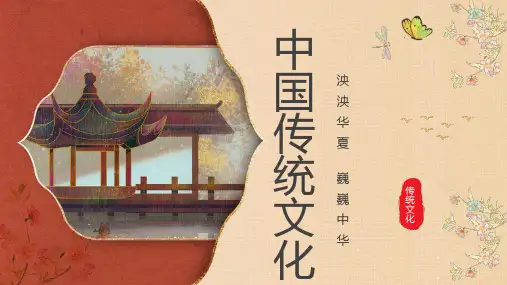
中国文化概况主讲教师: 朱丽明Allusions金玉其外,败絮其中:Rubbish coated in gold and jade一片冰心:Crystal-like heart kept in the jade flask---pure and innocent friendship.青梅竹马:Green plums and bamboo horses鸟尽弓藏:The bow is cast aside once the birds are gone.入境问禁On entering a country, inquire about what is forbiddenTraditional Chinese MedicineTraditional Chinese Medicine•Many Chinese people, especially the older generation, are accustomed to going to traditional Chinese doctors and using traditional Chinese remedies. Traditional Chinese medicine (TCM)has a history stretching back thousands of years. TCM is an extremely rich discipline, built upon the combined experiences of famous practitioners of past dynasties, and the extensive body of medical writings they produced.TCM considers Nature and Human to form a single whole, and emphasizes the philosophical concept known as"The Unity of Heaven and Human." Environmental factors such as the four seasons and changes in temperature and weatherbody, with the body and Nature forming an integrated system.•When the weather is hot in the springWhen the weather ishumid in summerWhen the weather isdry in the fall•When the weather iscold in winter•All parts and systems of the body are considered to be closely connected and mutually interacting. "The outside of the body is Yang, the inside is Yin; the back is Yang, the abdomen (腹部) is Yin."TCM utilizes Yin-Yang Theory and Five Elements Theory, which advocate "administering treatment according to pattern," rather than "treating the head when the head hurts; treating the foot when the foot hurts."•According to the Five Elements Theory, the liver and gallbladder(胆囊)are Wood, the heart is Fire (火), the spleen(脾)and stomach are Earth (土), the lungs and intestines(肠)are Metal (金), and the kidneys(肾)and bladder(膀胱)are Water(水).When Yin and Yang are out of balance,disease and disorder result.Methods of Diagnosis•The basics of TCM diagnostics are: observe (望), hear and smell (闻), ask about background (问) and read the pulse (切).Then classify the symptoms into different types (阴阳表里寒热虚实). TCM requires skill in a range of diagnostic systems not commonly used outside of TCM. Much of this diagnostic skill involves developing the abilities to observe subtle appearances;to observe that which is right in front of us, but escapes the observation of most people.Chinese medicine treats the root •Traditional Chinese remedies consist of natural preparations. Several thousand years of experimentation have determined the specific medicinal properties of numerous herbs, and the specific prescriptions and treatments that should be used for a wide range of conditions. The famous Compendium of Materia Medica(本草纲目), written by Li Shizhen during the Ming Dynasty (1368-1644), contains comprehensive descriptions of thousands of Chinese herbal remedies. Traditional Chinese remedies may either be taken internally or applied externally to promote the recovery of normal functioning, in accordance with the theory of "administering treatment according to pattern." Thus the saying, "Western medicine treats the symptom, Chinese medicine treats the root."The Popularity of TCM•As more people have become interested in alternative lifestyles in recent years, there has been a corresponding upsurge of interest in herbal medicine and non-pharmaceutical treatments. Traditional Chinese medicine and remedies have become increasingly popular around the world, and the number of Sino-foreign exchanges concerning traditional Chinese medicine and remedies has steadily increased. Japan, the United States, and Germany have established a number of cooperative projects with China, and the World Health Organization has opened seven traditional Chinese medicine centers in China.Methods of treatment•Herbal Medicine 中草药•Acupuncture 针灸& Moxibustion 灸术, 艾灼•Cupping 拔火罐•Massage 推拿•Diet therapy or food therapy 食疗•Gua Sha 刮痧•Qigong exercises and Medical Qikong 保健气功•Exercise therapy (Taijiquan and other Chinese Martial Arts)运动健身疗法中草药•This is the oldest form of Chinese medicine. This treatment originally required the patient to boil up medicinal plants and other medicinal substances, and drink the resultant liquid. These days Chinese Herbal Medicine is more commonly administered in the convenient form of powders that can be dissolved in water, or in the form of pills. Herbal Medicine is usually used to counteract the effects from excessive cold, heat, dampness or dryness, and to restore normal function of the organs.Acupuncture & Moxibustion •Acupuncture & moxibustion is a unique therapy of China. It is a kind of treatment curing inner diseases from outside, and is used to treat various illnesses based on the theories of channels and vital points with applications of specific techniques. Based on the diagnosis and therapy of traditional Chinese medicine, the doctor can find out the pathogeny (病原)of illnesses, distinguish the features of diseases, determine which channel and viscera(内脏)the pathological (致病的)change belongs to, and identify which type the illness belongs to (inner or outer; cold or heat; insufficiency or excessiveness), and finally make the diagnosis. Then, the doctor can prescribe the corresponding acupuncture to prevent and cure the diseases by dredging channels, regulating vigor and sap(元气), balancing Yin and Yang, and harmonizing the functions of the viscera.Cupping 拔火罐•In this modality ,glass or acrylic(丙烯酸)suction(吸入) cups are applied to specific areas of the body. It is a congested(使充血) treatment using a vacuum cup sucked firmly on the skin. Usually, the doctor fires an alcohol sponge(棉)and puts it inside the cup for a short while to make the cup a vacuum one, then he places the vacuum cup instantly over the selected spot of the skin. It is mainly used for conditions that are associated with “stagnation”(淤塞)which often manifests as chronic (慢性) pain.Massage 推拿•Chinese Massage uses a number of techniques, which are designed to release tightness in tissues(组织), stimulate specific points or areas, and facilitate the flow of Qi. Chinese massages are usually very relaxing, highly invigorating(令人爽快的)or both.。